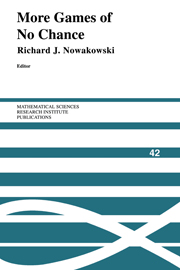Book contents
- Frontmatter
- Contents
- Preface
- The Big Picture
- Idempotents Among Partisan Games
- On the Lattice Structure of Finite Games
- More Infinite Games
- Alpha-Beta Pruning Under Partial Orders
- The Abstract Structure of the Group of Games
- The Old Classics
- Higher Nimbers in Pawn Endgames on Large Chessboards
- Restoring Fairness to Dukego
- Go Thermography: The 4/21/98 Jiang-Rui Endgame
- An Application of Mathematical Game Theory to Go Endgames: Some Width-Two-Entrance Rooms With and Without Kos
- Go Endgames Are PSPACE-Hard
- Global Threats in Combinatorial Games: A Computation Model with Applications to Chess Endgames
- The Game of Hex: The Hierarchical Approach
- Hypercube Tic-Tac-Toe
- Transfinite Chomp
- A Memory Efficient Retrograde Algorithm and Its Application to Chinese Chess Endgames
- The New Classics
- The 4G4G4G4G4 Problems and Solutions
- Experiments in Computer Amazons
- Exhaustive Search in Amazons
- Two-Player Games on Cellular Automata
- Who Wins Domineering on Rectangular Boards?
- Forcing Your Opponent to Stay in Control of a Loony Dot-and-Boxes Endgame
- 1 x n Konane: A Summary of Results
- 1-Dimensional Peg Solitaire, and Duotaire
- Phutball Endgames Are Hard
- One-Dimensional Phutball
- A Symmetric Strategy in Graph Avoidance Games
- A Simple FSM-Based Proof of the Additive Periodicity of the Sprague-Grundy Function of Wythoff's Game
- Puzzles and Life
- The Complexity of Clickomania
- Coin-Moving Puzzles
- Searching for Spaceships
- Surveys
- Unsolved Problems in Combinatorial Game Theory: Updated
- Combinatorial Games: Selected Bibliography With A Succinct Gourmet Introduction
Experiments in Computer Amazons
Published online by Cambridge University Press: 29 May 2025
- Frontmatter
- Contents
- Preface
- The Big Picture
- Idempotents Among Partisan Games
- On the Lattice Structure of Finite Games
- More Infinite Games
- Alpha-Beta Pruning Under Partial Orders
- The Abstract Structure of the Group of Games
- The Old Classics
- Higher Nimbers in Pawn Endgames on Large Chessboards
- Restoring Fairness to Dukego
- Go Thermography: The 4/21/98 Jiang-Rui Endgame
- An Application of Mathematical Game Theory to Go Endgames: Some Width-Two-Entrance Rooms With and Without Kos
- Go Endgames Are PSPACE-Hard
- Global Threats in Combinatorial Games: A Computation Model with Applications to Chess Endgames
- The Game of Hex: The Hierarchical Approach
- Hypercube Tic-Tac-Toe
- Transfinite Chomp
- A Memory Efficient Retrograde Algorithm and Its Application to Chinese Chess Endgames
- The New Classics
- The 4G4G4G4G4 Problems and Solutions
- Experiments in Computer Amazons
- Exhaustive Search in Amazons
- Two-Player Games on Cellular Automata
- Who Wins Domineering on Rectangular Boards?
- Forcing Your Opponent to Stay in Control of a Loony Dot-and-Boxes Endgame
- 1 x n Konane: A Summary of Results
- 1-Dimensional Peg Solitaire, and Duotaire
- Phutball Endgames Are Hard
- One-Dimensional Phutball
- A Symmetric Strategy in Graph Avoidance Games
- A Simple FSM-Based Proof of the Additive Periodicity of the Sprague-Grundy Function of Wythoff's Game
- Puzzles and Life
- The Complexity of Clickomania
- Coin-Moving Puzzles
- Searching for Spaceships
- Surveys
- Unsolved Problems in Combinatorial Game Theory: Updated
- Combinatorial Games: Selected Bibliography With A Succinct Gourmet Introduction
Summary
ABSTRACT. Amazons is a relatively new game with some similarities to the ancient games of chess and Go. The game has become popular recently with combinatorial games researchers as well as in the computer games community. Amazons combines global full-board with local combinatorial game features. In the opening and early middle game, the playing pieces roam freely across the whole board, but later in the game they become confined to one of several small independent areas.
A line segment graph is an abstract representation of a local Amazons position. Many equivalent board positions can be mapped to the same graph. We use line segment graphs to efficiently store a table of defective territories, which are important for evaluating endgame positions precisely. We describe the state of the art in the young field of computer Amazons, using our own competitive program Arrow as an example. We also discuss some unusual types of endgame and zugzwang positions that were discovered in the course of writing and testing the program.
1. Introduction
The game of Amazons was invented by Walter Zamkauskas. Two players with four playing pieces each compete on a 10 x 10 board. Figure 1 shows the initial position of the game. The pieces, called queens or amazons, move like chess queens. After each move an amazon shoots an arrow, which travels in the same way as a chess queen moves. The point where an arrow lands is burned off the playing board, reducing the effective playing area. Neither queens nor arrows can travel across a burned off square or another queen. The first player who cannot move with any queen loses.
Amazons endgames share many characteristics with Go endgames, but avoid the extra complexity of Go such as ko fights or the problem of determining the safety of stones and territories. Just like Go, Amazons endgames are being studied by combinatorial games researchers. Berlekamp and Snatzke have investigated play on sums of long narrow n x 2 strips containing one amazon of each player [1; 15]. Even though n x 2 areas have a simple structure, sum game play is surprisingly subtle, and full combinatorial game values become very complex.
Information
- Type
- Chapter
- Information
- More Games of No Chance , pp. 243 - 260Publisher: Cambridge University PressPrint publication year: 2002
